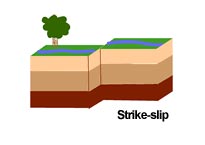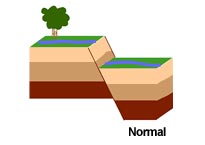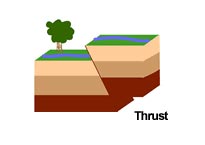But no destructive tsunamis were observed and seismologists said it was because it was a slip-strike quake that did not lead to a vertical displacement of waves.
British geological seismologist Susanne Sargeant was quoted as
 saying: “We have had two blocks rubbing together, it's called a
strike-slip earthquake ... That means there hasn't been any displacement
of the sea floor. Although an earthquake of this magnitude has the
potential to cause a large tsunami, the fact that we haven't seen any
drop of the sea floor, which is what generates the wave, it looks like
the possibility of a tsunami being generated is low".
saying: “We have had two blocks rubbing together, it's called a
strike-slip earthquake ... That means there hasn't been any displacement
of the sea floor. Although an earthquake of this magnitude has the
potential to cause a large tsunami, the fact that we haven't seen any
drop of the sea floor, which is what generates the wave, it looks like
the possibility of a tsunami being generated is low". Here’s all you need to know about the slip-strike earthquake:
Here’s all you need to know about the slip-strike earthquake:Earthquakes cause a fracture in the upper-most layer of the earth called the crust. This fracture divides the crust into blocks which move relative to one another. The movement of these blocks of crust is called a 'fault'. The fault can be of the following nature:
- Normal fault- The blocks, in this case, shift vertically. The rock above the fault moves down
- Thrust fault- In this case too, the blocks shift vertically, but the rock above the fault moves down
- Strike-slip faults- This is the term used for fractures when the blocks move horizontally (to the left or the
 right)
right)
Tsunamis are caused by the displacement of water. This displacement happens only due by vertical shift of the crust. Since the amount of water displaced by the horizontal movement of the crust is limited, chances of a tsunami, in this case, is less likely.
What does "tsunami"
mean?¸
Tsunami is a Japanese word with the English
translation, "harbor wave." "Tsu," means harbor, and
"nami," means waves. In the past, tsunamis were sometimes called
"tidal waves" by the general public, and as "seismic sea
waves" by the scientific community. A tsunami`s influence on a coastline
is dependent on the tidal level at the time a tsunami strikes, tsunamis are not
connected to the tides. Tides result from the imbalanced, extraterrestrial,
gravitational influences of the moon, sun, and planets.
How do tsunamis differ from other water waves?
Tsunamis are not like wind-generated waves, which many of us may have observed on a local lake or at a coastal beach, because they are shallow-water waves, with long periods and wave lengths.
How do earthquakes generate tsunamis?
Tsunamis can be generated when the sea floor suddenly deforms and vertically moves the overlying water. Tectonic earthquakes are a particular kind of earthquake that are associated with the earth's crustal deformation. Waves are formed when the displaced water mass, which is influenced by gravity tries to get its balance. When large areas of the sea floor rise or fall, a tsunami can be created.
What happens to a tsunami as it approaches land?
As a tsunami leaves the deep water of the open ocean and travels into the shallower water near the coast, it transforms. Tsunami travels at a speed which is related to the water depth. When it decreases, the tsunami slows. The tsunami's energy flux, which is dependent on both its wave speed and wave height, remains nearly constant. A tsunami, invisible at sea, may grow to be several meters or more in height near the coast. When it finally reaches the coast, a tsunami may appear as a rapidly rising or falling tide, a series of breaking waves.
What happens when a tsunami reaches land?
As a tsunami approaches shore, it begins to slow and grow in height. Just like other water waves, tsunamis begin to lose energy as they come onshore. Part of its energy is reflected on the sea. Tsunamis have great erosional influence. It takes away the sand from the beaches and it may take years for the trees and other vegetation to grow up again.Tsunamis may reach a maximum height onshore of 10, 20, and even 30 meters.
How much destruction do they cause?
Besides the horrible destruction of life that tsunamis cause, they have also caused massive physical damage. They have entirely destroyed buildings and left towns looking like a nuclear war zone.Can we detect them before they hit?
Yes. About 35 years ago, countries around the
Pacific set up the Pacific Tsunami Warning System. A group of seismic
monitoring stations are used for detection. The biggest problem with this
system is that it is difficult to predict how large and destructive the waves
will be. Scientists are now working on better predictive tools.
The most destructive tsunamis in history
were:
- 1782 –South China Sea
- 1883- South Java Sea
- 1868- Chile
- 1975-Hawaii
Scientists have found traces of an asteroid
crash which might have created an enormous tsunami around the Earth 4 billion
years ago. The coastline of the continents was changed drastically and almost
all life on land was destroyed. This is the first know meteor crash on Earth
and one of the four which are known in 300 million years. However, scientists
say that it is not known where the meter hit, but it was probably close to the
place where the stones of the meteorit werw found. They think this happened in
water not on the land.
I think I must
explain also some information about tsunami
• When the ocean is deep,
tsunamis can travel unnoticed on the surface at speeds up to 800 kilometers per
hour. Scientists are able to calculate arrival times of tsunamis.
• A tsunami may be less than 30
centimeters in height on the surface of the open ocean, which is why they are
not noticed by sailors. But the powerful shock wave of energy travels rapidly
through the ocean as fast as a commercial jet. Once a tsunami reaches shallow
water near the coast it is slowed down. The top of the wave moves faster than
the bottom, causing the sea to rise dramatically.
Many people have said a tsunami
sounds like a freight train.
I want to tell you something about the last great tcunami in Indian ocean
The epicenter of the 9.0
magnitude quake was under the Indian Ocean near the west coast of the
Indonesian island of Sumatra. A violent movement of the Earth's tectonic plates
displaced an enormous amount of water, sending powerful shock waves in every
direction.
The Indian Ocean tsunami caused
waves as high as 9 meters in some places, according to news reports. In other
places witnesses described a rapid rising of the ocean.
• The Indian Ocean tsunami is
the most dectructive on record. By the end of the day more than 150,000 people
were dead or missing and millions more were homeless in 11 countries, making it
perhaps the most destructive tsunami in history. A third of the people who died
in the Indian Ocean tsunami were children; many of them would not have been
strong enough to resist the force of the water.
Many people were killed by the Indian Ocean
tsunami because they went down to the beach to watch the ocean exposing the
seafloor.
Within hours killer waves
radiating from the epicenter hit the coastline of 11 Indian Ocean countries,
snatching people out to sea, drowning others in their homes or on beaches, and destroying
property from Africa to Thailand.
Tsunamis have been relatively
rare in the Indian Ocean. They are most common in the Pacific.
However many countries are at
risk.
The earthquake that generated
the great Indian Ocean tsunami of 2004 is estimated to have released the energy
of 23,000 Hiroshima-type atomic bombs, according to the U.S.
Geographical Knowledge Saved
Lives
People who knew geography knew
what the withdrawal ocean meant. Survivors who knew it meant trouble reported
how they ran for high ground, rounded up family and friends, and tried to warn
people who were drawn to the water's edge. Experts say that withdrawing ocean
may give people as much as five minutes' warning to escape to high ground. That
may have been enough time for many of the people who were killed by the 2004
tsunami to save themselves, if only they knew what to do.
A British newspaper reported
that a school student, on vacation in Thailand, recalled a geography lesson
about tsunamis and what the withdrawal of the ocean meant. She warned her
family and they saved themselves.
In India a man told the
Associated Press how he saved his village of some 1,500 people because he remembered
watching a National Geographic television documentary about tsunamis [Killer
Wave], and remembered that when the ocean withdrawal it was a sign of
danger. He sounded the alarm and led the people to high ground, saving almost
the entire village.
Somehow the animals also seemed to know that
disaster was coming. Many people reported that they saw animals running away
for high ground minutes before the tsunami arrived. Very few animal bodies were
found afterwards.
A baby was found floating
safely on a mattress.
The Indian Ocean tsunami
destroyed thousands of miles of coastline and even submerged entire islands
permanently.
And in the end:
The strongest earthquake to hit our planet in
the last 40 years has just caused a series of tsunamis that have greatly
destroyed the coasts of India, Thailand and many Indonesian islands. The
destruction and loss of life has been so catastrophic that the whole world
stood in shock at the power of nature. Many are worried that this could happen
again, somewhere else. Maybe at a coast near you.
generate - to generate a form
of energy or power means to produce it
crust- the earth`s
crust is its outer layer
shallow-if something is
shallow it has a short distance from the bottom to the surface
displace-if one thing displaces
another, it forces the other thing out of its place, position and then occupies
that place, position
tide- is the
regular change in the level of the sea on the shore
onshore- means
happening on or near land, rather than at sea
offshore- means situated or
happening in the sea, near to the coast
erosion- is the gradual
destruction and removal or rock or soil
in a particular area by rivers, the sea, or the wather
monitors- if you monitor
something, you regularly check its development or progress, and sometimes
comment on it
according to-if something is
according to something else, then the first thing changes in order to be suitable and correct for the second
thing
devastating-if you describe
something as devastating you are saying that it is very harmful or damaging
resist-if you resist someone
or resist an attack by them, you fight back against them
surface- of something is the
flat top part of it or outside of it.
rapid- a rapid change is one that happens
very quickly
withdrawal-the withdrawal of
something is the act or process of removing it, or ending it
random-a random sample or
method is one in which all the people or things involved have an equal chance
of being chosen
Three days ago there was a great earthquake
magnitude of 8.3, near the island of Sumatra again. The people were very
frightened. A lot of them went on high grounds because they thought that
tsunami might be created. Many people were hurt and a lot of buildings were
destroyed.
No comments:
Post a Comment